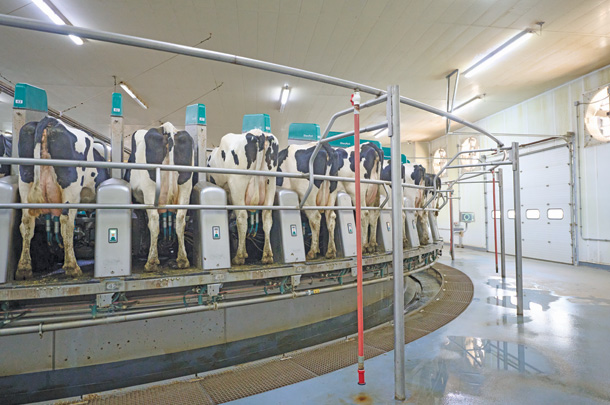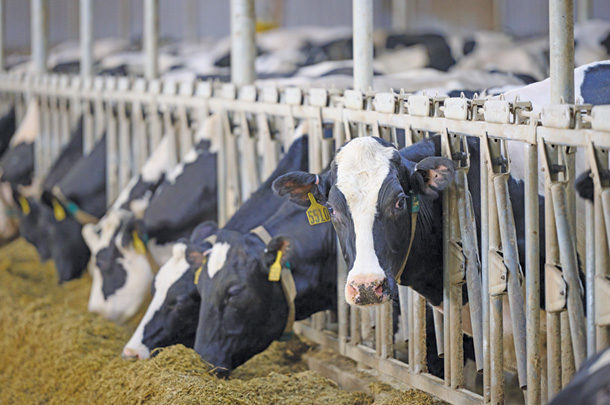Across the Northern Plains, when the thermometer plunges to -30ºF night after night and the northwest wind howls like a jet engine on takeoff, “strange things can happen” to dairy equipment – including even the latest automated technology, says Jon Qual of Qual Dairy, Lisbon, North Dakota. Batteries can die, diesel fuel can gel, ventilation fans can ice over, alley scrapers can lock up, manure pumps can plug, pits can freeze, and air sensors can go bonkers, opening barn curtains instead of closing them.
That’s why the Qual family takes many steps to prepare for what Jon calls “deep winter.” Jon operates their dairy with his brother Mark; their parents, Alan and Julie; their uncle, Rod; and their cousins, Nathan and Tyler. The Quals milk 1,300 cows on a GEA DairyProQ robotic rotary and house them in an insulated 330-foot-by-360-foot cross-ventilated barn.

A propane heating system keeps the parlor at 50ºF. Photo courtesy of GEA Farm Technologies.
No. 1: Propane
The first item on their “be-ready-for-an-Arctic-blast” list: Make sure there’s enough propane.
A propane heating system keeps the parlor at constant 50ºF. At that temperature, the robotic milkers function flawlessly, he says. Propane boilers also heat the water used to prep udders and wash the parlor equipment.
The Quals have two 1,000-gallon propane storage tanks on the farm and have CHS Dakota Plains Ag, their propane supplier, on something better than speed dial. The tanks have sensors that notify CHS automatically when propane levels fall to 30% of the tanks’ capacities. Jon gets an alert on his cellphone automatically, too.
The Quals also installed a propane vaporizer on their storage tanks. The vaporizer heats up the propane so the fuel – which is in a liquid form in the tank – will vaporize and flow to the parlor, even when temperatures bottom out.
No. 2: Back-up power
Next on their checklist for preparing for extreme cold is: Check their back-up power. The Quals have diesel-powered generators that automatically start up when the power goes out. They test them every Monday at 4 p.m. to make sure they are ready to go in an emergency. “The last thing you want is for the generator not to work when it is needed,” Jon says.
No. 3: Ventilation
In the cross-ventilated barn, there is no heat. The barn roof has 2 inches of insulation. The cows give off enough body heat themselves to keep the air temperature above freezing – if nothing goes wrong. The Quals shut off air sensors that automatically open and close the barn curtains. They set the curtain gap manually to eliminate the chance the sensors could malfunction, opening the curtains during the night when it is bitterly cold.
They turn 10 of the barn’s 90 ventilation fans on to circulate fresh air across the barn during extremely cold weather. They run the fans wide open so the exhaust doesn’t freeze on the fan shrouds or blades. It took some trial-and-error to figure out how many fans to run and what speed to run them for the best air quality, Jon says.
No. 4: Calves
Calves get special attention, too. The Quals remodeled a hoop barn where they house calves for one to two weeks after they are born. They put in a concrete floor with heat tubes in the floor. With a layer of straw on the concrete, the jacketed calves have warm nests even when a blizzard rages outside.
When calves are a couple of weeks old and eating some pellets, they move them to individual hutches. During extreme cold, they cover the hutch openings at night with plywood to keep out the wind and keep in the calves.
The Quals and their employees constantly patrol the dairy during an Arctic outbreak. They check waterers, manure pumps, alley scrapers, curtains and the robotic feed pusher several times a day. They smell the air for ammonia and feel the humidity in the air on their skin. They look for ice near the big doors on the end of the barn.
“We don’t let our guard down,” Jon says. “We don’t leave the dairy and just let it run on its automated settings when it gets really cold. We bundle up and deal with things until it warms up.”
Protecting milking robots
Linda and Michael Hanson and their sons, Matthew and Steven, of Good Vue Ayr Farm, Goodridge, Minnesota, have to brace for winter’s worst, too. But their situation is a little different than the Quals’. They milk 145 cows with two Lely A4 robotic milkers. They feed cows with a Lely Vector robotic feeding system.
The lactating cows and approximately 40 dry cows and springing heifers are housed in the unheated part of a 116-foot-wide-by-286-foot-long freestall barn.
The robot room, which contains the two robotic milkers, has in-floor heat. “We haven’t had to supplement it or use fans to circulate heat to the robot arms, and we do not use freezer-curtains around the boxes,” Linda says.
The robot room is surrounded by the other heated areas, except where the cows access the robots from the freestalls. Some heat is reclaimed in the utility room/robot area from the compressor, but the heat is not directed to the robot room.
A heated shop is part of the barn, too. The Hansons park skid-steer loaders, tractors and other essential equipment inside to keep them thawed out able to start even on the coldest days. They run a PTO electric generator off one of the tractors to supply electricity to the dairy when the power goes out.
During extremely cold weather, the Hansons keep the barn buttoned up. An overhead door between the shop and the freestall section of the barn lets them get equipment into the freestalls without having to open exterior doors. They don’t have to open up exterior doors to feed cows either. The Vector robot feeding system bunkers are located inside the barn.
“We make sure we fill them before it gets really cold,” Linda says.
The lowest temperature the Hansons have seen in their barn after several days of -35ºF was +36ºF.
“Hopefully, that is the worst we will ever see,” Linda says. “I don’t know what havoc several straight weeks of those kind of temps might create, but hope we don’t have to test it.”




